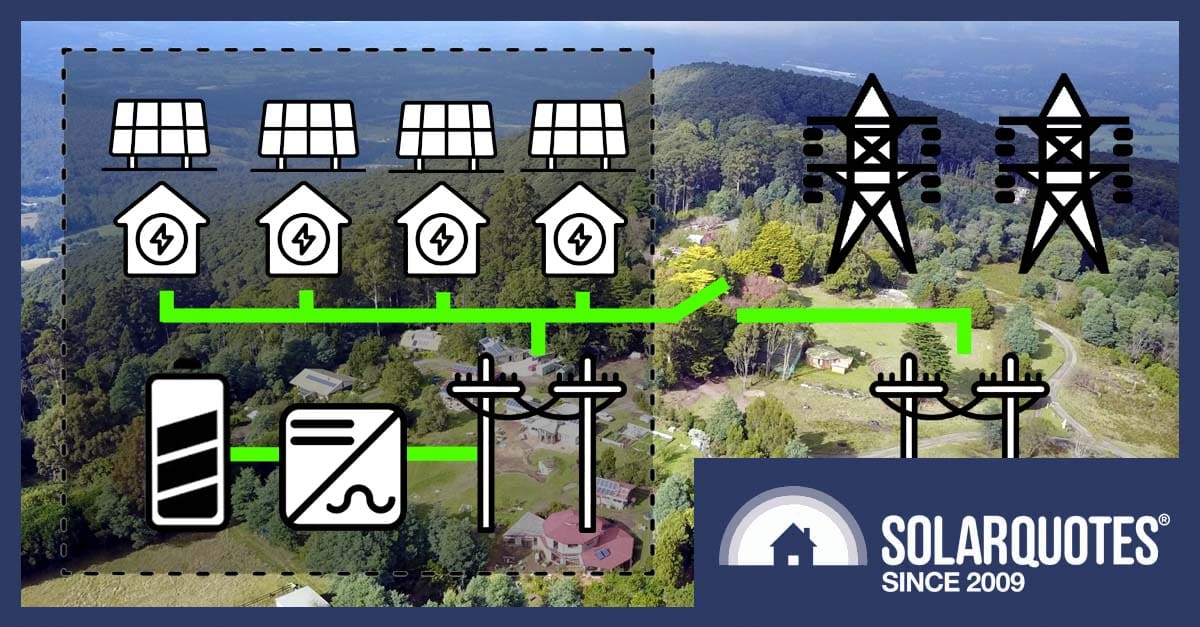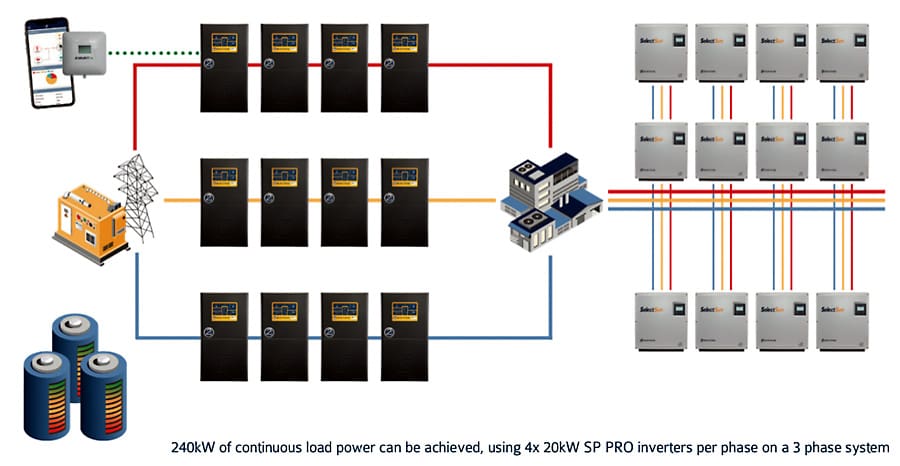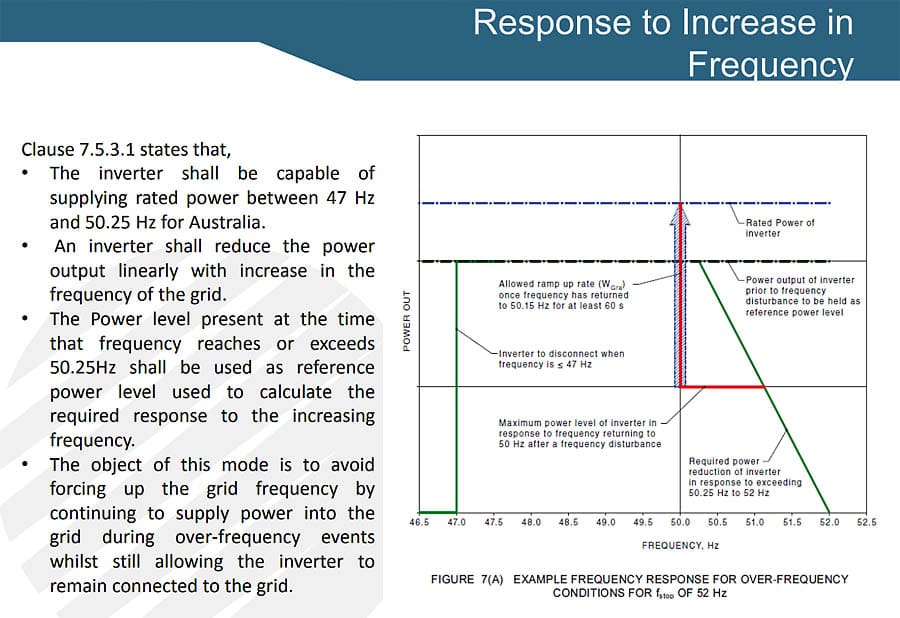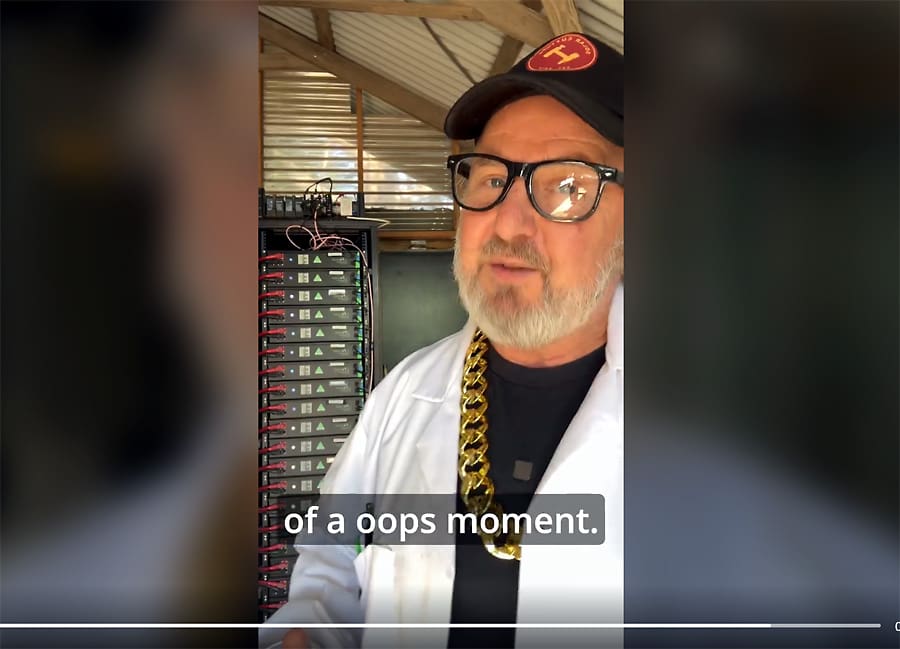
The future of energy is local, modular, and thrill-seeking – meet the microgrid, the little grid with big dreams of transforming how your appliances are powered and how your community copes with extreme weather.
Out in rural Victoria, a motley team of solar panels, inverters and batteries have teamed up to power a dozen homes. Led by lab director Professor Glenmo – part mad scientist, part renewable rabble-rouser – this scrappy microgrid is writing its own rulebook when it comes to keeping the lights on. Peak hour surges, multi-day storms, grid failures – bring it on. By pushing the operational boundaries, this tiny grid is lighting the way for all of us.
Glenmo’s relatively small 30 kW islanded grid-forming system currently controls 140 kW of connected solar panels scattered throughout the area on the microgrid. That’s a lot of solar to control when the grid goes down, and nothing’s left to soak up the excess solar power. In a recent video, Glenmo (AKA Glen Morris from Smart Energy Labs) explains how his microgrid system tames all those solar panels using Selectronic inverters and a clever trick from the Australian standard for grid-connected inverters to help out.
Quick Definitions for Newcomers
Before we dive in, here are some basics for those new to the topic:
Microgrid: A local energy system that creates, stores, and shares electricity independently. It often uses renewable sources like solar and wind. Microgrids can run on their own and/or connect to the main power grid.
Islanded: In renewable energy, “islanded” means a system is operating autonomously, separate from the main power grid.
Grid-Forming: A power source, like a renewable energy system, that can set and maintain stable voltage and frequency levels. It synchronizes multiple energy sources, enabling a reliable power supply.
Smart Energy Lab Microgrid
In the video below, check out Professor Glenmo explaining how his microgrid works, and then read on for more insights. If this piques your interest, Glen will be running an online ‘Microgrid Design Course’ in January 2024. Details are provided at the end of the article.
System Components
Let’s start with a breakdown of his grid-forming system components, which include 30 kW of battery inverters and an 80 kWh battery stack. Additionally, the microgrid connects to 140 kW of distributed solar generation.
Microgrid (3-phase grid-forming system)
- 30 kW of battery inverters: 6 x Selectronic SP PRO inverters (2 x 5 kW per phase) connected by Selectronic Powerchain.
- 80 kWh battery stack: (60 kWh usable) 20 x Power Plus Energy LiFe4838P batteries.
Microgrid (distributed generation)
- 140 kW of connected solar: Seven homes and six labs comprising 28 inverter systems, including 4 x 20 kW Selectronic SelectSun inverters (now discontinued) controlled by the SP Pro inverters using Selectronic Powerchain.
Selectronic Powerchain is Selectronic’s software-based solution for direct management of solar. It enables linking multiple SP PRO bi-directional battery inverters, whether single or multi-phase, on or off-grid.

This diagram shows a Selectronic Powerchain at full capacity – 240 kW of continuous power using a maximum of 4 x 20 kW SP Pros per phase, allowing up to 480 kW of managed AC coupled PV inverters. Glen’s grid-forming system is nowhere near as big – only 30 kW (2 x 5 kW SP Pros per phase managing 80 kW of SelectSun PV inverters, and an additional 60 kW unmanaged PV.)
Sizing The Grid-Forming System
The next question that comes to mind is, “How big a grid-forming system would you need for a microgrid?” Over to the Professor for this one:
“The lesson with microgrids is you need to size the grid-forming system to cope with the maximum demand when there are no other sources available. Or, you have a backup generator system, which we do. We’ve got a 22kVA generator here as a backup solution.”
It’s not just the maximum demand you have to worry about. Let’s fast forward a bit to get some more key information.
“So, you’ve got to size your sources to consider your grid-forming system first, how big it’s going to be, and whether it can absorb and control the amount of connected generation.”
The key information here is “absorb and control the amount of connected generation.” That’s a Herculean task, considering the 30 kW grid-forming system has somehow to absorb a potential 140 kW of connected generation!
And here’s the clever thing – it doesn’t have to. This is why.
Australian Standards To The Rescue
Australian standards get more of their fair share of rubbishing from the electrical industry, so it’s refreshing to highlight an instance where a ruling is put in for good reason. Without it, this microgrid system may even be unworkable.
The standard is AS/NZS 4777.2 Grid connection of energy systems via inverters, Part 2: Inverter requirements. Glen explains here:
“And what do you know, out of the box, without any configuration, they (inverters) have to do what’s called frequency power reduction. That means as the frequency climbs, the output power reduces. So these clever inverters here, from Selectronic, they actually lift the frequency when they need less power from other sources, such as conventional grid-tie inverters or hybrid systems that are also connected on one or more phases on the microgrid.”
That sounds like a ‘hold your breath, cross your fingers’ kind of moment, and hope that all connected inverters ramp down as expected if the frequency climbs above set thresholds.

Clause 7.5.3.1 states the required response to increase in frequency for grid-connected inverters. Note that this graphic is from an ‘Overview of Revised AS/NZS4777.2 for the previous edition. Until Standards Australia get their sh*t together and make standards a fair and equitable price, it’s the best I can do. Thanks Google. Image: Geoff Stapleton
Selectronic Powerchain Is In Control (Sort of)
Fortunately, over half of this microgrid’s connected solar generation doesn’t have to rely on frequency power reduction as outlined in the AS/NZS 4777.2 standard. There are also four 20 kW SelectSun 3-phase grid-tie inverters, which are controlled via the battery inverters using the aforementioned Selectronic Powerchain.
So, with Powerchain in control and the rest of the inverters limited by frequency power reduction, as stated in the standard, what could possibly go wrong? Lots, it seems! Selectronic have a limit of two to one for managed AC coupling. So, for every kilowatt of SP Pro you have, you can have 2 kilowatts of PV inverters.
By that requirement, Glen’s SelectSun managed PV is over by 20 kW, and he has another 60 kW of PV relying on frequency power reduction. No problem. It’s a test facility, right? Glen likes to push the boundaries to find answers. Over to you, Professor:
“Four 20 kW Select Suns (PV inverters), which are Modbus-controlled by these Selectronic (battery) inverters because they’re basically a Selectronic solution for direct management of solar. So the remaining solar, which is scattered across all the homes and labs here at the Smart Energy Lab, relies on that frequency shift power control. And sometimes it doesn’t ramp down fast enough. And what do you know, boom, we exceed the battery voltage!”
Oops, The Grid’s Gone Out!
And when that happens, the lights go out, or maybe not.
“There’s something special about these batteries. They look after themselves. If they see a high voltage spike on any of the cells, they’ll shut down. Now, that’s a bit of an oops moment. But on a microgrid, it doesn’t mean the homes lose power. It just means that the grid’s gone. And these homes all have hybrid systems on them.”

Professor Glenmo and his microgrid battery stack. “A bit of an oops moment!”
So, all the homes on this microgrid have a battery backup and still have power when the grid goes down. I expect everyone affected would know that Glen’s probably out in his shed playing with electricity again when this happens, and it’s just another day at the office.
As you’ve probably guessed, this may not be a typical microgrid enjoyed by your average paying punter. Most systems in the customer-orientated world would likely be overbuilt for resilience. Glen would be the best person to tell you about that, so why don’t you ask him?
Microgrid Design Course
Glen will run an online microgrid design course on Wednesday, 24th and Thursday, 25th January 2024 (1:30 pm – 5:30 pm Melbourne time.) The course consists of two four-hour sessions designed to provide participants with an in-depth understanding of designing microgrid solar and battery power systems in compliance with AS/NZS standards.
You can get more details and register here.

 RSS - Posts
RSS - Posts



Thanks Kim for the best piece of writing ever about me and my crazy microgrid.
👍
Very interesting.
I’d have thought though that you’d need more battery storage?
I guess it would be wise to watch the video before I comment further.
I will do that now.
Hi David, yes, we have way too little battery capacity for winter time… the 80kWh battery stack get’s 60-100% cycled everyday and if there’s not enough sun the following day… the generator has to come on.
I might be out of date, but wouldn’t some small scale wind turbine(s) go some way to alleviating the need for extra battery storage?
Jay,
Take a look at a few Youtube videos posted by folk who have tried that.
Small wind turbines are always on modest towers, so too close to the ground for useful wind speed, resulting in desultory output. Yes, a VAWT will do a little bit better, but still not enough to contribute usefully to powering a home in any situation I’ve seen.
Paying for one is fiscally unwise. DIY is educational – just keep well clear of rotating blades.
You’re welcome Professor. Thanks for the opportunity.
Thank you, Kim.
A very helpful article on a complicated system.
Much appreciated.
Andrew
Small typo – those are clauses 4.5.3.1, not 7.5.3.1 in AS 4777.2. There is no section 7.5.
4777.2:2015 defo has 7.5.3.1. I’m looking at it now – has 4777.2:2020 renumbered the sections? I need to update my copy…
Thanks for the update Mitch. As explained, the graphic is from an earlier edition of AS/NZS4777.2. You’re welcome to post a link to the wording of the current ruling in the 2020 edition (if one exists on the web.) That would help out a lot of people.
With a distributed diverse microgrid, complexity is bound to sneak in sooner or later. However, the basic principle which Glen has so eloquently explained, is also present in quite a number of single-home AC + DC coupled domestic systems.
My brother has two PV inverters (AC coupled) and two DC coupled Victron Multiplus IIs. The latter can throttle the former via delta-f, as Glen outlines, or by comms, if the PV inverters have compatible firmware. His has only 19 kW of array, and 15 kWh of LTO batteries, and is still grid connected. It works well for his use case. I’m guessing it would easily function as part of one of Glen’s microgrids, if the opportunity arose. (But supply over property boundaries is illegal?)
My incipient install is planned around three Multiplus IIs and two 6 kW PV inverters, which will also need to be throttled by comms or delta-f, just like a little microgrid. I’m told that the PV inverters respond more quickly to load transients than do the MPPTs supplying the battery inverters, thus reducing battery microcycles. (For what that’s worth.) The 46 kWh of battery is delivered, but the 31 kW of PV array is yet to come. I’ve seen Victron’s DVCC (Distributed Voltage & Current Control) mode elegantly managing load power and battery charge rate simultaneously, for minimal battery cycling when PV production is sufficient. I.e. dynamic MPPT throttling, tracking load.
Off-grid, I figure that turning off elective loads during inadequate insolation is the most viable way to preserve battery charge for nights and following grey days. And rather than design for maximum possible demand, economics dictates constraining switched on loads to available capacity. In extremis, the BMSs set a hard limit anyway. Pull too much battery current, and you’re disconnected. Better to have the HWS on a diverter, and use only “excess PV” for EV charging.
It would be interesting to know if economics regulates individual consumption vs production in a microgrid.
Glen,
After some tweaking of the Re-bulk offset, I have DC generation dispatching within tens of seconds, but the PV inverters contribute nothing in low insolation, as the Multiplus IIs fail to drop the frequency from 52.8 Hz, despite significant battery drain.
That’s presumably the result of dufus programming in the Cerbo GX controller.
It is frustrating to see the MPPTs providing a kW or two in total overcast, but the AC coupled 60% of the arrays shut out by 52.8 Hz obstinate throttling.
Here in winter, room and water heating can be biomass powered, but a bit more oomph for EV charging would be very useful. It would be a helluva disappointment to have to fire up the generator. (Who wants a remote-motor hybrid?)
Hi Erik,
I love hearing about your adventures, please keep the details coming, it sounds like something we could write an article on.
In the meantime I’ll just leave this here 😉
https://www.solarquotes.com.au/blog/selectronic-sp-pro/
Anthony,
If we hang fire until I lay my hands on the compact electric tractor that the manufacturer assures me is going through final productionising for release this quarter, then there’ll be something new. (They did go a bit quiet after I badgered them about the safety, cycle life, SoC tolerance, price, and increased weight (good on a small tractor), advantages of LiFePO₄ over their 1st generation’s Li-Ion batteries. An upgrade would be appealling.)
As for Selectronic battery inverters, they were my first preference, but they require Microsoft software, and in decades in IT I’ve never touched the stuff. Also, the open source Linux based Victron software is something I can delve into, given enough rain over winter to keep me indoors. (I’m just back from a 3 km return walk to the back paddock to dig up 124 Serrated Tussocks with a mattock – enough for this 70 yo to deserve a coffee and a TimTam. Why count kills? The yearly stats tell me who’s winning, me or the tussocks. They’re indigestible to stock, so wad up in the intestines – not good. Too much silica, I seem to recall. They don’t even burn properly, dammit.)
The story here has a Climate Resilience element. I’ve nearly finished installing the second set of three 31,700 L poly water tanks, for a total tank farm over 200,000 L – enough for a very dry year and a bit to spare. Tomorrow night the shire council is holding an “Emergency Preparedness Drop In Session” in the public hall. It’ll be interesting to see what they can advise. My father’s favourite saying was “If there must be panic, let it be organised.” I figure we’ll get to that stage by the end of the decade or so.
(Without doubt if the Thwaites Glacier has done its thing by then.)
Might a larger scale version of this be the future for towns and communities outside state capitals? With grid power becoming increasingly expensive and unreliable, plus solar panels becoming increasingly common and a fair few postcodes and suburbs having more than 70% of homes with a system, why preserve a centralised\interconnected grid for anything other than commercial purposes?
There are reports of sections of rural towns receiving street-scale batteries to off-load the network from excess solar power at midday, and from high demand at dusk. A start has been made, but the next decade ought to be eye-popping with luck and increasing fear of the +3 deg we’re aiming at by our actions. As you imply, will there be any remnant of a monopolistic centralised grid then? With fossil burners bankrupt, and nuclear unviable unless subsidised to the tune of billions by taxpayers hard pressed to put a roof over their heads, a resilient distributed mesh of producers and local consumers might be all that is economically feasible.
As Glen said, we don’t have enough batteries yet, individually or collectively. But we will. Solar panel prices dropped 90% in the last half decade or so, and are set to halve again, as production and installation go ballistic. Improved battery performance is seen monthly, at least at lab scale, and Na-Ion seems set to cut battery manufacturing costs to a quarter. Little need for generators then, once savings are passed on. (And hopefully only biofuel available for the generators before long.)
If only we were a species which understood nonlinear systems, and with enough nouse to be wary of runaway positive feedback. Oh well, aging populations presage a global population decline, so there’ll be room for the environmental refugees, I guess. The 2m of rain in 5 days in FNQ is just the beginning, as +1 degC is +7% atmospheric moisture, and +3 degC is +21%. The energy in the condensing moisture fuels cyclones, as well as dumping oceans of rain. How long? How long before we collectively wake up enough to act urgently? (Oh, I forgot. We’re experiential learners, largely blind to foresight. May we survive the experiment.)
Hi George
Yes, it’s totally doable on a small development scale. It’s really just a “back to the future” move… before the NEM… power was distributed locally from various generation sources.
In fact… for some “green field” developments, an islanded or weakly connected microgrid is more cost effective than running HV to a remote location.
WA has many such systems on the Horizon Network.